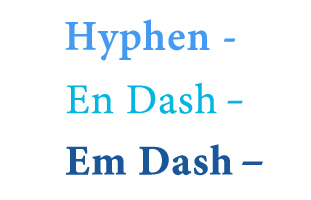There are a few rules guiding the use of hyphens and dashes in writing. Some of these rules are instinctual, but some are also easy to forget or lose track of. In this post, we’ll look at the differences between the hyphen and the various forms of dashes.
When to Use a Hyphen
The hyphen is a punctuation mark used between compound words and names or between the syllables or characters of a word. The hyphen generally acts to connect things together. We see it most in its role in connecting compounds. For instance,
- My older brother is a grown-up (compound word).
- My great-grandmother and I just had lunch (compound name).
- High-school students enjoy going to football games (compound modifier).
- Senator Kennedy won his re-election campaign (connecting prefix and root).
We also see the hyphen when they separate letters or numbers that are not inclusive, numbers like telephone and ISBN book numbers.
- My name is Greg; that is spelled G-R-E-G.
- Jenny’s phone number is 867-5309.
There are actually two main forms of dashes: the en dash and the em dash. Most people aren’t familiar with the differences between the two, but they both have their own distinct purposes.
When to Use an En Dash
 The en dash is much less versatile than the em dash and is therefore used much less frequently. The en dash’s primary function is to indicate a range of inclusive numbers. For example,
The en dash is much less versatile than the em dash and is therefore used much less frequently. The en dash’s primary function is to indicate a range of inclusive numbers. For example,
- My college years, 2009–2012, were the best years of my life.
- Our party will be this Friday, 6:30 p.m.–7:30 p.m.
- The Red Wings won 2–1.
In the above sentences the en dash is being used as “to.” But, we should remember, when the first element is preceded by “from” or “between,” we never use the en dash. For example,
- I was in college from 2009 to 2012.
- The truck driver made three stops between 9:00 a.m. and 5:00 p.m.
When to Use an Em Dash
The em dash is used in many more ways than the en dash. When people talk about using dashes, they are almost always referring to the em dash. The most common way to use the em dash is to amplify or further explain a passage:
- The protesters were becoming restless—favoring revolution to reason.
- My best friend—well, my former best friend—betrayed me last night.
- Is there any way—any way at all—that I could borrow your pencil?
The amplifying, or sometimes exclamatory, nature of the em dash is what sets it apart from commas, parenthesis, or colons. If you wish to give a certain sentence a little more jazz or emphasis, an em dash might be more appropriate than simple opting for commas. For instance, in the above “pencil” example, the dashes may be more appropriate than a set of commas in order to amplify my desperate need for a pencil.
The em dash is also used to indicate sudden breaks in thought or speech:
- Can you—will you—help me with this English project?
- I would like a small—no large—pizza for dinner!
In order to avoid confusion in your sentences, you should never use more than two em dashes per sentence.
Putting this into Microsoft Word
Now you might be saying, this is all well and good, but how do I insert these into my text?
Well, inserting hyphens is as easy as hitting the hyphen key on your keyboard,
- High-school athletics were very popular at my school.
Inserting an en dash is a bit more tedious but still easy nonetheless. Begin by typing a space and then the two hyphens. For example,
- The 2011 (hyphen) (hyphen) 2012 school year was my favorite year.
- This sentence will automatically be converted into
- The 2011 – 2012 school year was my favorite year.
Then you will simply need to eliminate the two spaces between 2011 and 2012, so your final sentence will appear as,
- The 2011–2012 school year was my favorite.
To insert an em dash into Word type two hyphens in between a word with no spaces. For example,
- Will you(hyphen) (hyphen)can you(hyphen) (hyphen)show me how to insert an em dash?
- The above sentence will automatically be converted into
- Will you—can you—show me how to insert an em dash?
Contents
